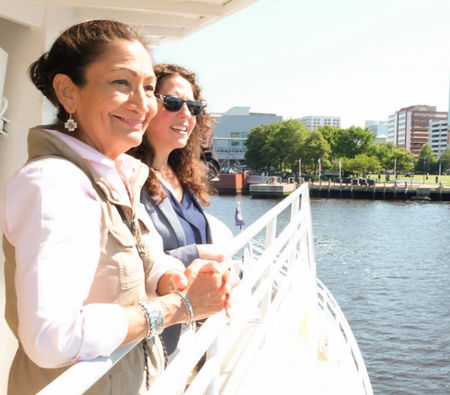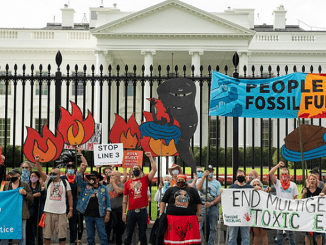
BOSTON, Massachusetts, October 14, 2021 (ENS) – At least 16 wind energy projects are in the works for offshore locations around the United States, at various stages of development and more will be starting soon. Interior Secretary Deb Haaland Wednesday outlined the path forward for future offshore wind leasing to meet the Biden-Harris administration’s goal of deploying 30 gigawatts of offshore wind energy by 2030.
There are just seven turbines with a capacity of 42 MW installed in U.S. waters today, compared to more than 20 GW in Europe.
Haaland announced plans for the Bureau of Ocean Energy Management, BOEM, to hold up to seven new offshore lease sales by 2025, during her speech at the American Clean Power’s Offshore Windpower Conference & Exhibition in Boston.

The lease sales would be held for wind areas in the Gulf of Maine, New York Bight, the Central Atlantic, and the Gulf of Mexico, as well as offshore the Carolinas, California, and Oregon, she said.
“The Interior Department is laying out an ambitious roadmap as we advance the administration’s plans to confront climate change, create good-paying jobs, and accelerate the nation’s transition to a cleaner energy future,” said Secretary Haaland.
“This timetable provides two crucial ingredients for success: increased certainty and transparency. Together, we will meet our clean energy goals while addressing the needs of other ocean users and potentially impacted communities,” she declared. “We have big goals to achieve a clean energy economy and Interior is meeting the moment.”
As directed by President Joe Biden’s Executive Order 14008, Tackling the Climate Crisis at Home and Abroad, the Interior Department has partnered with other federal agencies to increase renewable energy production on public lands and waters. Plans include a commitment to deploy 30 gigawatts of offshore wind by 2030 and a target goal of permitting at least 25 gigawatts of onshore renewable energy by 2025.
BOEM is working on refining its process for identifying additional areas that may be suitable for offshore wind energy leasing. The agency is developing clear goals, objectives, and guidelines that can be shared with government agencies, Tribes, industry and ocean users, before identifying such areas.
“We are working to facilitate a pipeline of projects that will establish confidence for the offshore wind industry,” said BOEM Director Amanda Lefton. “At the same time, we want to reduce potential conflicts as much as we can while meeting the administration’s goal to deploy 30 GW of offshore wind by 2030. This means we will engage early and often with all stakeholders prior to identifying any new Wind Energy Areas.”

Ledfton said BOEM will use the best available science as well as knowledge from ocean users and other stakeholders to minimize conflict with existing uses and marine life.
In addition to identifying new offshore wind lease sales, BOEM is considering innovative lease stipulations consistent with the goals and objectives of the Outer Continental Shelf Lands Act. Lessees may have to report on efforts to minimize conflicts with other ocean users; on mechanisms for project labor agreements; and on investments in the U.S. domestic supply chain.
Such stipulations were included in the New York Bight Proposed Sale Notice announced in June of this year.
The BOEM is currently reviewing 10 Construction and Operations Plans with the intention of completing the review of at least another six by 2025, for a total of at least 16 COP reviews representing more than 19 GW of clean wind energy.
Earlier this year, BOEM completed its review of a Construction and Operations Plan for the Vineyard Wind project, about 15 miles south of Martha’s Vineyard and Nantucket, Massachusetts.
This project, in the planning stages for years, has aroused opposition so strong that a group of residents is taking the matter to court.
The group ACK Residents Against Turbines filed suit in August against Vineyard Wind’s proposed project of some 60 turbines 14 miles south of the island, arguing that the turbines threaten the survival of a dwindling number of endangered Northern Atlantic right whales that inhabit the surrounding waters.
The plaintiffs maintain that the windpower site is in a crucial area for foraging and nursing for the species, which researchers estimate number less than 400 whales.
Mary Chalke, a Nantucket resident and member of the opposition group, said the lawsuit isn’t just about Vineyard Wind, but other turbine projects also in the pipeline up and down the Eastern Seaboard.
“We all want renewable energy,” she told the “Providence Journal” newspaper after the group filed the suit in Boston federal court. “This represents the transformation and industrialization of a pristine natural environment.”
Featured image: The two wind turbines currently in operation in Hampton Roads, Virginia are the first installed in U.S. federal waters and are avoiding up to 25,000 tons of carbon dioxide emissions annually. (Photo courtesy Dominion Energy)



